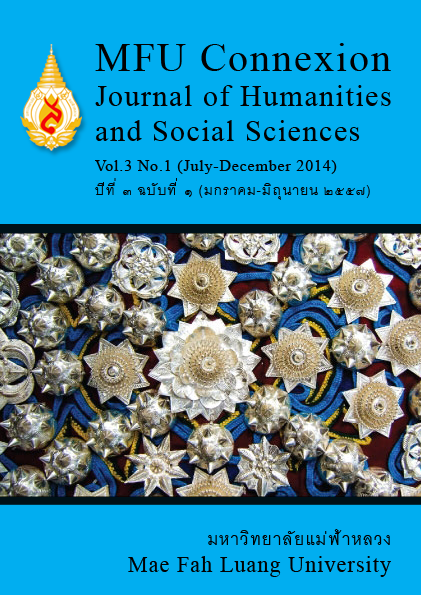Implementation of Self-Directed Learning into English Courses at Mae Fah Luang University
Main Article Content
Abstract
The study aimed to investigate the implementation of self- directed learning (SDL) into English courses at Mae Fah Luang University (MFU). The study focused on how SDL was implemented in the English course syllabus at MFU and what students’ attitudes towards integration of SDL into course were. Data were collected from documents, course syllabi and course materials, and the participants; 2 course syllabus designers who designed Academic Reading and Writing (ARW) course and 153 students who undertook ARW course. The research was conducted by distributing questionnaire to 153 students, and then 15 out of 153 students were interviewed to gain more information about attitudes towards integration of self-directed into the course. The results revealed that there had been a development of implementation of SDL into the curriculum at MFU since it was established. The English Department responded to the policy of implementation of SDL from the executive administrator by integrating SDL into the courses by designing syllabi which incorporated self-study tasks. In addition, the students seemed to have positive attitudes towards integration of SDL into the course. They agreed to have SDL integrated into the course.
Article Details
Copyright
Connexion: Journal of Humanities and Social Sciences has an exclusive right to publish the accepted articles in any form. However, the author retains the following rights:
1. The right to the ownership of the article;
2. The right to use all or part of the article in his/her other works;
3. The right to re-produce the article for personal use or for use in the author’s organisation, in which case the author must obtain permission from Connexion: Journal of Humanities and Social Sciences;
4. The right to make copies of all or part of the work for educational use or for the author’s use in classroom teaching; and
5. The right to include the work (both the preprinted and printed versions) in an institutional repository.
References
Adediwura, A. A. & Tayo, B. (2007) Perception of teachers’ knowledge, attitude and teaching skills as predictor of academic performance in Nigerian secondary schools, Educational Research and Review, 2(7), pp. 165-171.
Anon. (1999) National education act B.E. 2542 (1999) and amendments (Second National Education Act B.E. 2545 (2002)), Bangkok.
Barett, A. (1995, 13-15 March 1995) Linking SAC tasks to classroom activities. Paper presented at the Self Access Learning and Learner Independence: A South East ASEAN Perspective, Bangkok.
Charubusp, S. (2004) EFL instruction and self-access language learning at a univeristy in Thailand: A teacher study group investigation, Master of Education, Brock University, Ontario.
Clemente, M. D. L. A. (2001) Teachers attitudes within a self- directed language learning scheme, System, 29(1), pp. 45-67.
Colman, J. (1987) The Problem of Continuity: Possible solutions, In J. Burton (Ed.) Implementing the Learner-Centred Curriculum, 1, pp. 67-91. Sydney: Macquarie University.
Dickinson, L. (1987) Self-instruction in language learning, Cambridge: Cambridge University Press.
Dickinson, L. (1993) Talking shop, ELT Journal, 47(4), pp. 330-336.
Ellis, R. (1994) The study of second language acquisition, Oxford: Oxford University Press.
Gardner, D. & Miller, L. (1999) Establishing self-access from theory to practice (1st ed.), Cambridge: Cambridge University Press.
Geddes, M. & Sturtridge, G. (1982) Individualisation. Hong Kong: Modern English publications.
Hartmann, P. (2007) Quest 2: Reading and writing (2nd International Edition ed.), Singapore: McGraw Hill.
Hiemstra, R. (1994) Self-directed learning, Available: https://www-distance.syr.edu/sdlhdbk.html [Accessed 26 June2012]
Hughes, P. (2003) Autonomous learning zones, Paper presented at the 10th European Conference for Research on Learning and Instruction, Padova, Italy.
Kirtikara, K. (1996) Autonomy rediscovered, Paper presented at the Autonomy 2000: The Development Learning Independence in Language Learning, King Mongkut’s Institute of Technology Thonburi, Bangkok.
Lin, L. Y. (1995) The self-access centre in specialist teachers training institute (STTI) Kualalumpur, Malaysia, Paper presented at the Self-Access Learning and Learner Independence: A Southeast Asean Perspective, The Royal River Hotel, Bangkok.
Lewis, M. & Reinders, H. (2008) Using student-centered methods with teacher-centered students (2nd ed.), Ontario: Pippin Publishing Corporation.
Morrison, B. (2008) The role of the self-access centre in the tertiary language learning process, System, 36(2), pp. 123-140.
Navarro, D. & Thornton, K. (2011) Investigating the relationship between belief and action in self-directed language learning, System, 39(3), pp. 290-301.
Nesi, H. (1995) Self-access through a computer network, Paper presented at the Self-Access Learning and Learner Independence: A Southeast Asean Perspective, The Royal River Hotel, Bangkok.
Nunan, D. (1988) The learner-centred curriculum, Glasgow: Cambridge University Press.
Pang, T. T. T. (1995) Incorporating self-access elements in a taught course, Paper presented at the Self Access Learning and Learner Independence: A Southeast Asean Perspective, Bangkok.
Reuchakul, P. (1995) Self-access learning at Chaiwanwittaya school, Paper presented at the Self Access Learning and Learner Independence: A Southeast Asean Perspective, Bangkok.
Riangrila, P. & Thongthai, W. (2009) A self-reliance instruction: A case study of Sammasigkha Pathom Asoke school, Kamphaengsaen Academic Journal, 7(3), pp. 28-42.
Rodgers, T. & Richards, J. (1987) Teacher-based curriculum development illusion or reality, In J. Burton (Ed.) Implementing the Learner-Centred Curriculum 1. Sydney: Macquarie University, pp. 28-29.
Scharle, A. & Szabo, A. (2000) Learner autonomy: a guide to developing learner responsibility, Cambridge: Cambridge University Press.
Shujun, Q. & Qian, L. (2006) A Survey on English majors attitudes towards learner autonomy, CELEA, 29(5), pp. 66-74.


